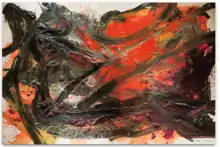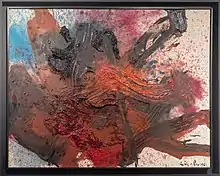Kazuo Shiraga
Kazuo Shiraga (白髪 一雄, Shiraga Kazuo, August 12, 1924 – April 8, 2008) was a Japanese modern artist who belonged to the Gutai group of avant-garde artists. He was acknowledged internationally only after his death.
Kazuo Shiraga | |
|---|---|
| Native name | 白髪 一雄 |
| Born | August 12, 1924 Amagasaki, Japan |
| Died | April 8, 2008 (aged 83) Amagasaki, Japan |
| Occupation | Painter |
| Nationality | Japanese |
Introduction
Shiraga is said to have seen the viscosity of tube-ready oil paint as "free." This is compared to the paints he was forced to use in painting school, which were thin ink-based paints. Shiraga would experiment by using his hands and fingers with oil paints in his younger years.[1]
Early life
In the 1940s he studied Nihonga at the Kyoto City University of Arts. In 1953 he founded the group "Zero Kai" with Akira Kanayama, Atsuko Tanaka and Saburo Murakami which merged with Gutai in 1955.[2]
Gutai and painting with feet
Shiraga created "mud paintings" by using his whole body to leave impressions in wet mud.[3] For over ten years, from 1956 to 1966, his Performance Paintings were largely painted with his feet. Later he was influenced by Frenchman Jean-Jacques Lebel. His most valuable work is also from around the same period 1958 to 1963.

The highest prices fetched for shiraga work are typically from this period. During this period Shiraga also experimented with sculture like when he did an untitled red fan in (1965).[4]

.png.webp)
The Katana swordsmiths series
In the early sixties, Shiraga started an interesting series of works dedicated to famous japanese Katana makers from the 14th and 15th century: Yukimitsu (行光), Kanemitsu (兼光), Kaneyoshi (兼吉), Sadamune (貞宗), Kanesada (兼定). His paintings bear on the back the name of the swordsmith enclosed in a stylised cartouche in the shape of a katana.

Becoming a Monk
1971-72 he lived as a Buddhist monk. His technique during this period evolved a bit with the presence a scraping sometime in a circular movement that is not unlike the one used by Gerard Richter. But this period - caracterized also by duller colors during the seventies.

Also typical for this period is the use of wood as a support to replace the canvas.
progressively from eighties : the return of bright colors
After the seventies from the eighties bright color return sometime almost monochrome (using one main color on the canvas). The results are very pleasing and commercially successful. Also large size canvas are more frequent during this late period.

Auctions and notable sales
In December 2014 his prime-period 1961 abstract, “Chijikusei Gotenrai,” was sold for 3.25 million euros, about $3.7 million.[5] Those prices would later be topped first in 2015 where the 5 million mark was achieved finally with current world record being for Takao a 1959 piece that sold in June 2018 in Paris for 8.7 million euros. followed by Tentaisei Soushiko, 1960 that sold for 7.8 million euros .
Awards
- 2002: Osaka Art Prize
References
- "Kazuo Shiraga". Lévy Gorvy. Retrieved 2019-03-21.
- Artnet
- Goldberg, Roselee (2004). Performance: live art since the 60s. Thames & Hudson. p. 17.
- New York Times, Feb. 27, 2015; Scott Reyburn "Art World Rediscovers Kazuo Shiraga"
